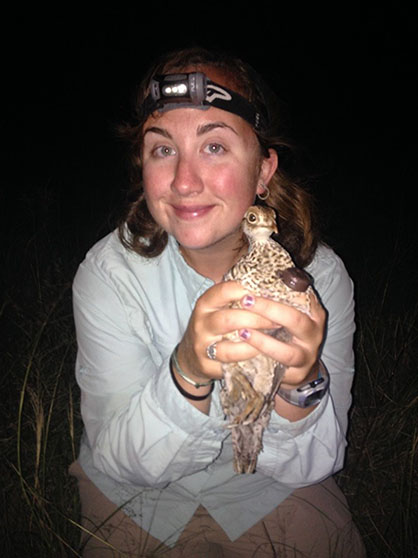Landscape Conservation Design, Movements, and Survival of Lesser Prairie-Chickens in Kansas and Colorado
 Investigator:
Investigator:
Samantha Robinson, M.S. Student
Project Supervisor:
Dr. David Haukos
Funding:
Kansas Department of Wildlife, Parks and Tourism
Cooperators:
Christian Hagen
Kansas Department of Wildlife, Parks & Tourism
Kansas State University
USDA NRCS
USDA FSA
Location:
Throughout Kansas and Eastern Colorado
Completion:
December 2015
Status:
Completed
Objectives:
Determine the effect of fragmentation on survival.
Estimate non-breeding season survival, measure non-breeding season movements, home range and habitat use.
Understand the link between free-water use and egg development.
Assess the risk of fence collision across the northern distribution.
Progress and Results:
The lesser prairie-chicken (Tympanuchus pallidicinctus) has experienced range-wide population declines and range contraction since European settlement. Due to ongoing declines, lesser prairie-chickens were listed as threatened under the Endangered Species Act in 2014; however, uncertainty regarding the legal status of the species has developed following a judicial decision to vacate the listing in September 2015. Regardless, new research is required for conservation planning, especially for understudied portions and temporal periods of the occupied range. I evaluated nonbreeding lesser prairie-chicken survival using known-fate models, and tested for the influence of environmental, landscape and predator effects on weekly survival. I estimated nonbreeding home-range size using fixed kernel density estimators and Brownian Bridge movement models for VHF and Satellite tagged lesser prairie-chickens, and measured habitat use during the 6-month nonbreeding period (16 September - 14 March) following the breeding seasons of 2013, 2014 and 2015. I also determined the influence of lek location on space use intensity within home ranges using resource utilization functions. Female survival was high (0.73; 95% CI = 0.65-0.81) and consistent across nonbreeding seasons, but not explainable by selected variables. Mean home range size for birds with GPS transmitters (x̄ = 997 ha) increased 181% relative to the breeding season and home range size was smaller in the 2013-2014 season (x̄ = 494.7 ha) than the 2014-2015 (x̄ = 1290.1 ha) and 2015-2016 (x̄ = 1158.1 ha) seasons. Home range size of birds with GPS transmitters were 249% larger than for individuals with VHF transmitters (x̄ =285.7 ha). Males and females were tied to leks throughout the nonbreeding season, and this relationship was not variable across the months of the nonbreeding season. Proportions of habitat used differed among study sites, but temporal trends were not evident. Lesser prairie-chickens exhibited consistency among ecoregions for home-range, space use, and survival; however, with differing habitat use among regions, management should be on the regional scale.
Agriculture and energy development have caused fragmentation of the landscape where lesser prairie-chickens evolved. I used known fate survival models to test if landscape composition or configuration within sites caused survival to differ by site, as well as within home ranges to determine if functional relationships exist between weekly survival and landscape configuration or composition. I used Andersen-Gill models to test whether distance to anthropogenic features affected hazard rates. Differences in survival rates between sites, with survival rates 50% greater in Clark County, Kansas compared to Northwestern, Kansas, corresponded to differences in the amount of grassland habitat on the landscape, but study-site configuration was not measurably different. Increasing the number of patch types within home ranges increased survival, indicating positive effects of heterogeneity. In addition, as distance to fences decreased, lesser prairie-chickens experienced greater risk. Overall, further breakup of grassland landscapes that lesser prairie-chickens occupy should be avoided, to avoid habitat loss and fragmentation thresholds that could further affect survival rates. Additionally, fences should be removed or avoided around active leks.
Products:
Thesis:
Robinson, Samantha (M.S., 2015; advisor Haukos) Landscape Ecology, Survival and Space Use of Lesser Prairie-Chickens, Kansas State University.
Publications:
Robinson, S.G., D.A. Haukos, R.T. Plumb, C.A. Hagen, J.C. Pitman, J.M. Lautenbach, D.S. Sullins, J.D. Kraft, J.D. Lautenbach. 2016. Lack of lesser prairie-chicken mortality due to fence collisions in Kansas and Colorado. Journal of Wildlife Management 80:906-915.
Robinson, S.G., D.A. Haukos, D.S. Sullins, and R.T. Plumb. 2016. Use of free-water by nesting lesser prairie-chickens. Southwestern Naturalist 61(3), pp.187-193.
Professional Presentations:
Robinson, S., R. Plumb, D. Haukos, C. Hagen, J. Pitman, and B. Sandercock. 2016. Come rain or no water, I will survive: nonbreeding lesser prairie-chicken survival and space use. North American Ornithological Congress, Washington, D.C.
Robinson, S., R. Plumb, D. Haukos, S. Carleton, A. Meyers, and J. Reitz. 2015. There is no space like home:space use of nonbreeding lesser prairie-chickens. Annual meeting of the Central Mountains and Plains Section of The Wildlife Society, Manhattan, Kansas.
Robinson, S., R.T. Plumb, J.M. Lautenbach, D.S. Sullins, J.D. Kraft, and D.A. Haukos. 2015. Attributing landscape characteristics to lesser prairie-chicken survival in Kansas and Colorado. Biennial meeting of the Prairie Grouse Technical Council, Nevada, Missouri.
Robinson, S., R.T. Plumb, J.M. Lautenbach, D.S. Sullins, J.D. Kraft, D.A. Haukos, C.A. Hagen, and J.C. Pitman. 2015. Functional relationships among lesser prairie-chicken survival, habitat type, and landscape fragmentation. International Grouse Symposium, Reykjavik, Iceland.
Robinson, S.G., and D.A. Haukos. 2015. The influence of habitat composition and configuration on lesser prairie-chicken survival rates in Kansas. Annual Meeting of the Kansas Ornithological Society, Emporia, KS.
Robinson, S.G., D.A. Haukos, and J.C. Pitman. 2015. Nonbreeding season movement and space use of lesser prairie-chickens in Kansas. Kansas Natural Resource Conference, Wichita.
Robinson, S.G., R.T. Plumb, J.M. Lautenbach, D.A. Haukos, S. Carleton, A. Meyers, and J. Reitz. 2015. Space use by nonbreeding lesser prairie-chickens. Joint meeting of American Ornithologists' Union and Cooper Ornithological Society, Norman, OK.
Robinson, S., R. Plumb, J. Lautenbach, D. Haukos, and J. Pitman. 2014. Nonbreeding season movement and habitat use of lesser prairie-chickens in Kansas. Joint meeting of American Ornithologists' Union, Cooper Ornithological Society, and Society of Canadian Ornithologists, Estes Park, Colorado.